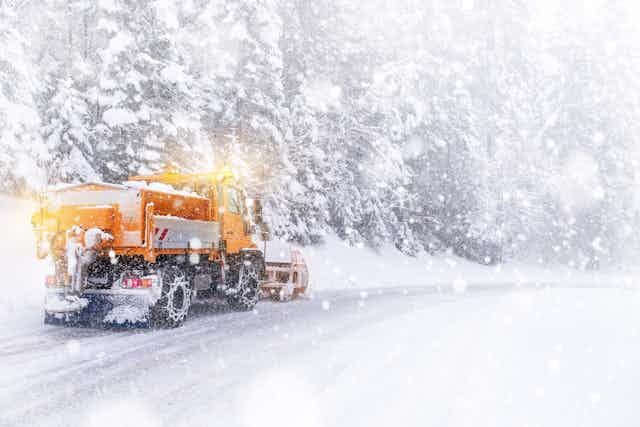When the weather takes a wintery turn, many cities and municipalities in North America rely on rock salt to deice their roads. Rock salt helps keep roads safe by reducing accidents, but it can also have serious, negative effects on aquatic ecosystems.
Marshes, streams and lakes lie alongside many of the roads and highways that zigzag across North America. Plants and animals inhabit these water bodies and can be exposed to many of the substances we put on those roads.
Rock salt is similar to table salt, made up of sodium and chloride, but coarser. It dissolves quickly on the road, leaving the chloride to flow into nearby waterways.
At low concentrations, chloride is relatively benign. But as concentrations rise, it can be toxic and fatal to aquatic wildlife, including plankton and fish. These ecological changes affect water quality.
At high concentrations, salt can also change the way water mixes and lead to the formation of salty pockets near the bottom of lakes, creating biological dead zones.
These risks have led to studies exploring how much salt enters the environment and freshwater — and led some communities to look for environmentally friendly alternatives.
In salt water
A little development can lead to a lot of salt entering a body of water. One study of North American lakes found that paving as little as one per cent of the land area within 500 metres of a lake increased risk of of that lake becoming saltier over the longterm. About 27 per cent of large lakes in the United States are at least one per cent developed along their shores.

Salt concentrations in many U.S. lakes will fall outside the bounds necessary for healthy aquatic plants, animals and microorganisms — and for palatable drinking water — by 2050.
Canada will likely face the same issue. Depending on the severity of the winter, approximately seven million tonnes of road salt are applied annually to Canadian roads. Many municipalities in southern Ontario use more than 100,000 tonnes per year.
Road salt applications in Canada began in the 1950s. To fully understand how these increasing chloride concentrations have affected lake ecosystems, we must look back in time. But there’s little long-term data about these lakes, so we examine past environmental conditions by coring into the lake bottoms and using the information preserved in the lake sediments.
A window into the past
Clay, silt, sand, pollen, chemicals and other substances from the surrounding environment accumulate slowly — and continuously — in layers at the bottom of lakes. That sediment provides a natural archive of past conditions. For example, a layer with a lot of charcoal may indicate increased forest fires in the region.
Scientists use the information preserved in this archive to understand how environmental conditions have changed over long periods of time — from years to centuries.
The Muskoka region of central Ontario — known for its lakes, rivers and cottages — has used road salt since the 1950s. The remains of algae and microscopic animals (called zooplankton) contained within the region’s lake sediments show us that changes have occurred in these lakes, coinciding with the onset of road salt applications in the region.
We’ve found there are more salt-tolerant zooplankton species now than there were before road salt was widely used. The effect of that shift isn’t fully understood, but we do know that when things change at the lower levels of the food web, the effects may be felt through the whole ecosystem.
Consider, for example, a fish that has become adapted to eating one type of zooplankton. If all of a sudden it is replaced by another type — perhaps one that is larger — it may run into trouble.
Chloride can be toxic to zooplankton. At lower concentrations it can weaken individuals and raise rates of egg mortality. Fish are generally more tolerant to increasing salt concentrations, but the negative effects increase the longer they are exposed to high chloride levels. Many young fish feed on plankton and if they lose their food source, they will not thrive.
Brine alternatives
Some communities in North America are looking for environmentally safe alternatives to road salt.
Beet wastewater — left over from sugar beet processing — cheese brine, pickle juice and potato juice are some of the unconventional deicers being tested.
The carbohydrates or sugars in beet wastewater make it more effective at lower temperatures than salt water or brine alone, lowering the melting point of the ice to below -20 C from -10 C — and reducing the amount of chloride applied to the road.
But there are downsides. Some communities dislike the smell of the beet wastewater, which people have likened to soy sauce, molasses or stale coffee. New research also shows that road-salt additives like these can change the ways ecosystems function and lower the amount of oxygen they contain, which can kill fish and other aquatic life. These alternatives should be used with caution.
Instead of using salt and salt additives, some engineers are experimenting with roads that clear themselves of snow and ice. Early tests have suggested that solar panels could replace asphalt to melt ice and eliminate the need for road salt, by heating water in pipes embedded in the road.
Others are looking for more effective ways to use rock salt — and reduce the amount that enters aquatic ecosystems. Some rock salt bounces off the road when it’s applied so trucks tend to apply more than necessary. Wetting the pavement and applying brine solutions help the salt adhere to the road, meaning cities and municipalities can cut back on how much they use.
Scientists are also helping to figure out how much salt our lakes can handle, which species are at risk and which lakes are most sensitive to road salt exposure. We’re still trying to understand the best ways to keep humans safe on the road and plants and animals safe in our lakes, streams and wetlands.

